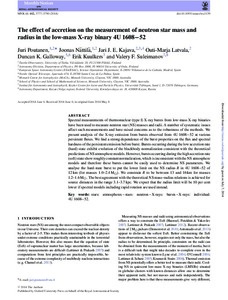The effect of accretion on the measurement of neutron star mass and radius in the low-mass X-ray binary 4U 1608-52
Juri Poutanen; Joonas Nättilä; Jari J. E. Kajava; Outi-Marja Latvala; Duncan K. Galloway; Erik Kuulkers; Valery F. Suleimanov
https://urn.fi/URN:NBN:fi-fe2021042714310
Tiivistelmä
Spectral measurements of thermonuclear (type I) X-ray bursts from low-mass X-ray binaries have been used to measure neutron star (NS) masses and radii. A number of systematic issues affect such measurements and have raised concerns as to the robustness of the methods. We present analysis of the X-ray emission from bursts observed from 4U 1608−52 at various persistent fluxes. We find a strong dependence of the burst properties on the flux and spectral hardness of the persistent emission before burst. Bursts occurring during the low accretion rate (hard) state exhibit evolution of the blackbody normalization consistent with the theoretical predictions of NS atmosphere models. However, bursts occurring during the high accretion rate (soft) state show roughly constant normalization, which is inconsistent with the NS atmosphere models and therefore these bursts cannot be easily used to determine NS parameters. We analyse the hard-state burst to put the lower limit on the NS radius R in 4U 1608−52 of 12 km (for masses 1.0–2.4 M⊙). We constrain R to be between 13 and 16 km for masses 1.2–1.6 M⊙. The best agreement with the theoretical NS mass–radius relations is achieved for source distances in the range 3.1–3.7 kpc. We expect that the radius limit will be 10 per cent lower if spectral models including rapid rotation are used instead.
Kokoelmat
- Rinnakkaistallenteet [27094]
